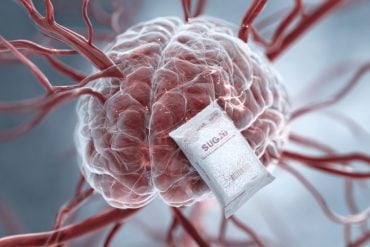Summary: Gene expression patterns in four regions of the prefrontal cortex are distinctly different in those who have been diagnosed with PTSD compared to those who have not. Major differences were seen in interneurons, which inhibit the immune system and microglia in the central nervous system. Findings shed light on why women are more likely to experience PTSD and compound a link between post-traumatic stress and a dampening of the immune system.
Source: Yale
A post-mortem analysis of brain tissue from people who had been diagnosed with post-traumatic stress disorder (PTSD) may help explain enduring mysteries about the disorder, such as why women are more susceptible to it and whether a dampened immune system response plays a role in dealing with stress, a team headed by Yale University researchers has found.
The analysis of gene expression patterns in brain tissue located in four regions of the prefrontal cortex — areas of the brain associated with higher cognitive function and executive control — revealed distinct differences in those who had been diagnosed with PTSD and those who had not. Major differences in gene activity particularly affected two cell types in PTSD patients — interneurons, which inhibit neural activity, and microglia, immune system cells in the central nervous system, the researchers report Dec. 21 in the journal Nature Neuroscience.
“The findings suggest that together these changes might contribute to an impaired ability to respond to traumatic stress,” said Matthew Girgenti, a research scientist in the Yale Department of Psychiatry and lead author of the study.
About 8% of the general population has been diagnosed with PTSD. But among those who have experienced severe psychological stress — including combat veterans, refugees, and victims of assault — as many as 35% exhibit PTSD symptoms. These symptoms include re-experiencing traumatic events, avoidance of others, and hyperarousal when exposed to events that remind the individuals of their traumatic experience.

While the types of cells most profoundly impacted by PTSD were the same in men and women, there were distinct differences between genders in where within the prefrontal cortex the genes impacting those cells were expressed. These differences might help explain why women are more than twice as likely to develop PTSD and other anxiety disorders than men and why they are likely to experience more severe symptoms, the findings suggest.
About half of PTSD patients are also diagnosed with some form of depression. However, gene expression patterns found in brain tissue are more closely linked biologically with schizophrenia and bipolar disorder than depression, the researchers found.
“This is a new beginning for the PTSD field,” noted Yale’s John Krystal, the Robert L. McNeil, Jr. Professor of Translational Research, professor of psychiatry, neuroscience, and psychology, and co-senior author of the paper. “We need new treatments for PTSD, and studies like this will provide the scientific foundation for a new generation of medication development efforts.”
Funding: The study was supported by the National PTSD Brain Bank, a U.S. Department of Veterans Affairs-based tissue bank which collects, processes, and shares research specimens for scientific research. The bank is led by Matthew Friedman of the White River Junction VA Medical Center and Dartmouth University, who is a co-senior author of the study.
Other co-senior authors from Yale are Hongyu Zhao and the late Ronald Duman.
About this PTSD research news
Source: Yale
Contact: Bess Connolly – Yale
Image: The image is in the public domain
Original Research: Closed access.
“Transcriptomic organization of the human brain in post-traumatic stress disorder” by Matthew J. Girgenti, Jiawei Wang, Dingjue Ji, Dianne A. Cruz, Victor E. Alvarez, David Benedek, Christopher Brady, David A. Davis, Paul E. Holtzheimer, Terence M. Keane, Neil Kowell, Mark W. Logue, Ann McKee, Brian Marx, Deborah Mash, Mark W. Miller, William K. Scott, Thor Stein, Robert Ursano, Erika J. Wolf, Murray B. Stein, Joel Gelernter, Keith A. Young, Bertrand R. Huber, Douglas E. Williamson, Matthew J. Friedman, John H. Krystal, Hongyu Zhao & Ronald S. Duma. Nature Neuroscience
Abstract
Transcriptomic organization of the human brain in post-traumatic stress disorder
Despite extensive study of the neurobiological correlates of post-traumatic stress disorder (PTSD), little is known about its molecular determinants. Here, differential gene expression and network analyses of four prefrontal cortex subregions from postmortem tissue of people with PTSD demonstrate extensive remodeling of the transcriptomic landscape. A highly connected downregulated set of interneuron transcripts is present in the most significant gene network associated with PTSD. Integration of this dataset with genotype data from the largest PTSD genome-wide association study identified the interneuron synaptic gene ELFN1 as conferring significant genetic liability for PTSD. We also identified marked transcriptomic sexual dimorphism that could contribute to higher rates of PTSD in women. Comparison with a matched major depressive disorder cohort revealed significant divergence between the molecular profiles of individuals with PTSD and major depressive disorder despite their high comorbidity. Our analysis provides convergent systems-level evidence of genomic networks within the prefrontal cortex that contribute to the pathophysiology of PTSD in humans.






